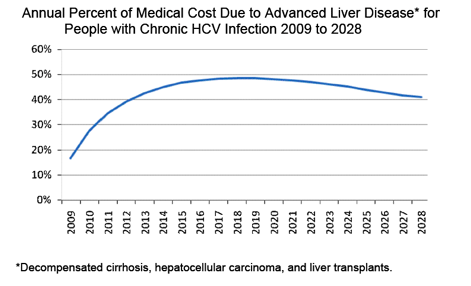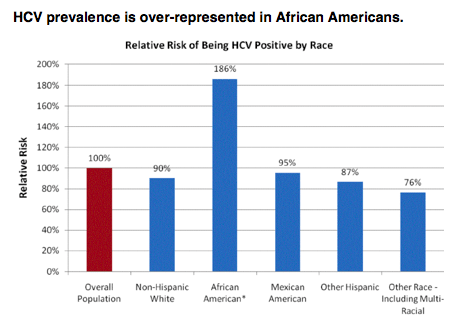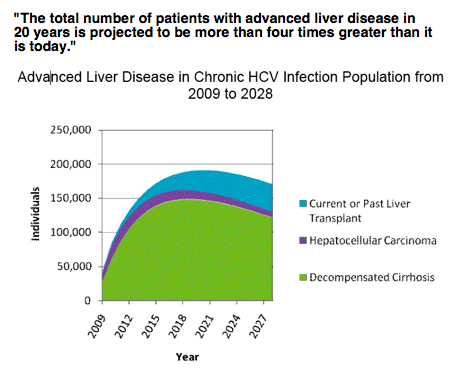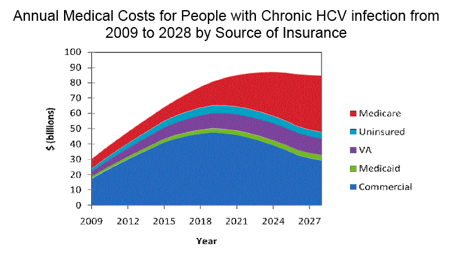| |
Consequences of Hepatitis C Virus (HCV): Costs of a Baby Boomer Epidemic of Liver Disease
MAY 2009
|
| |
| |
Pdf of full report attached
Link to Millman Report:
http://www.vrtx.com/millimanreport.html
Reported by Jules Levin
Bruce Pyenson, FSA, MAAA
Principal & Consulting Actuary
Kathryn Fitch, RN, MEd
Principal & Healthcare Management Consultant
Kosuke Iwasaki, FIAJ, MAAA
Consulting Actuary
Milliman, Inc.
This paper was commissioned by Vertex Pharmaceuticals Incorporated and
reflects the research of the authors.
"Author Conclusions
Our projections suggest that without improvements to the current low effective treatment rate, the U.S. healthcare system will be burdened with more HCV-infected patients progressing to cirrhosis, decompensated cirrhosis, and hepatocellular carcinoma, and ultimately, more patients requiring liver transplants. As more HCV infected people progress to advanced liver disease, we project these serious conditions to generate a rapidly growing portion of medical costs for HCV-infected people over the next 5 to 10 years, and lead to a dramatic increase in costs over the next 20 years. In the
absence of improved and accessible treatments that can alter the progression of disease, payers, especially Medicare, will feel the impact of a baby boomers' advanced liver disease epidemic."
"we estimate that only approximately 22% of those infected with HCV are diagnosed......While new HCV infections have declined dramatically over the last two decades, at least 3 million Americans are chronically infected with HCV. Most of these individuals are baby boomers, the generation born between 1946 and 1964, and more than three out of every four (78%) are unaware of their infection."
"We estimate that about 1.0% of Americans have chronic HCV infection. Most current estimates of the prevalence of HCV infection, including ours, are derived from National Health and Nutrition Examination Survey (NHANES), which has tested its sample of non-institutionalized Americans for HCV since the 1980s. We note that NHANES may underestimate prevalence"
"Over the next 10 years, the number of patients with decompensated cirrhosis will more than quadruple, up from 30,000 to almost 150,000. The number of patients with hepatocellular carcinoma will triple from 5,000 to approximately 15,000. The dramatic increase to liver transplants in the above chart includes both new liver transplants to HCV patients and the survivors of liver transplants starting in 2009. The high mortality rates of these severe conditions mean that many people who have just been diagnosed with these conditions may live only a few years."
"we still face an escalation of health care expenditures generated by the population with chronic infection. As the disease progresses and baby boomers age, most payers will bear an increasing cost burden for patients with HCV infection."
"The advanced liver disease that we are seeing today is likely just the beginning consequences of the baby boomer epidemic of chronic HCV infection. The chart below demonstrates that while less than a quarter of HCV-infected patients' medical costs are currently due to complications, progression of the disease will quickly change this dynamic dramatically. We expect these serious conditions will make up a rapidly growing portion of medical costs for HCV patients - increasing from under 20% to almost 50% - over the next 5 to 10 years. Over the next 10 years, commercial and Medicare costs for people with chronic HCV infection will more than double"



"Total medical costs for patients with HCV
infection are expected to increase more
than 2.5 times, from $30 billion to over $85 billion
over the next 20 years."
"In summary, without changes to the HCV diagnosis and treatment
paradigm,
· Overall health care costs will grow more than 2.5 times over 20
years
· The per-patient cost of people with chronic HCV infection will
increase 3.5 times over 20 years
· In 10 years, commercial and Medicare costs will more than double
· In 20 years, Medicare costs will increase 6-fold."
"Medicare will bear responsibility for a growing portion of patients with chronic HCV infection - increasing from 12% to 39% in 2028."

|
|
| |
| |
|
|
|